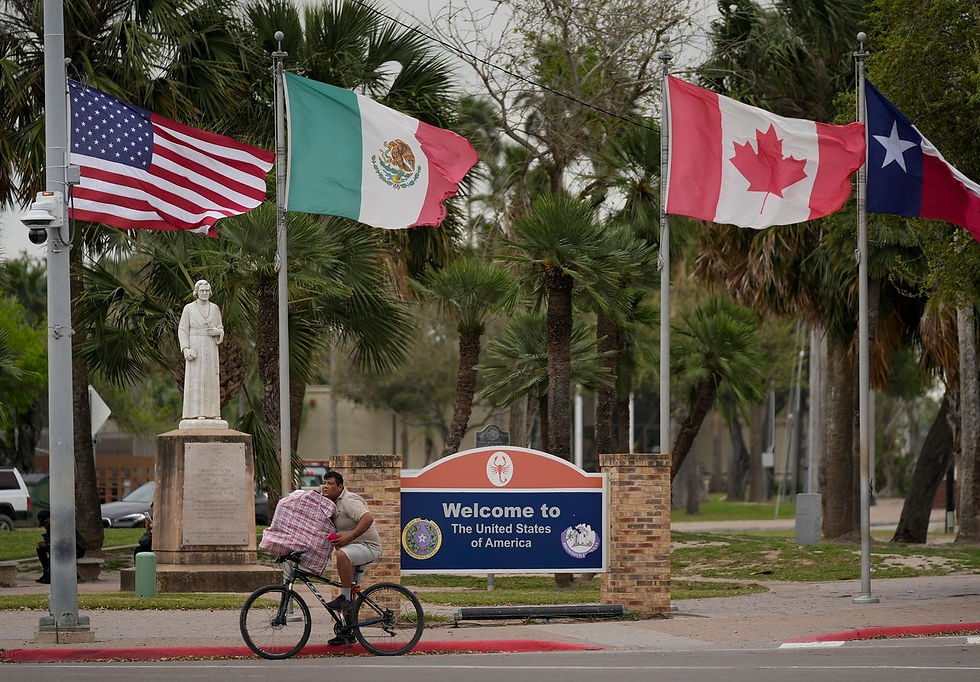Border towns are anticipating an immigration solution from President Biden and former President Trump, a resolution that has not been delivered by any previous administration.
- Octopus Media

- Feb 29, 2024
- 4 min read

BROWNSVILLE, Texas – As President Joe Biden arrives here sometime Thursday, this city in the southernmost crook of the Rio Grande will be kicking off Charro Days.
People will spill into the streets as they have since 1938 to celebrate all things Mexican in Brownsville, with mariachi bands, a bullfight and a parade that includes floats from Matamoros, Mexico, its sister city across the bridge.
Around the same time, the president will meet with Border Patrol and local law enforcement officials, continuing his pivot toward tough border enforcement as immigration becomes one of his biggest re-election liabilities.
And the same afternoon, ex-President Donald Trump will arrive upstream in Eagle Pass, where state-run border enforcement efforts have turned the city park into a militarized zone lined with steel fencing and razor wire.
The backdrops for these two visits help define two visions of the American immigration system.
Prep for the polls: See who is running for president and compare where they stand on key issues in our Voter Guide
In Eagle Pass, Republican Gov. Greg Abbott and his border initiative known as Operation Lone Star have framed the border as a dangerous beachhead in an immigration fight that now spills into cities across the country. Almost everyone has grown accustomed to daily flows of migrants in Brownsville, a city where the international bridge drops into town right between the community college campus and the Ross Dress for Less. Immigration officials here process asylum-seekers daily while thousands more wait their turn in camps across the river – outside the United States. Which version of the border voters accept as reality – or which vision they choose – is now likely to define the presidential election. For the first time since last decade, Americans now believe immigration to be the most important issue facing the United States, a Gallup pollreleased this week revealed.

For the people at the border, meanwhile, any campaign stop will simply showcase an immigration system that continues to disrupt their communities – and a political one that has yet to deliver them a solution. “Do either of these people – President Biden or Trump – have a positive vision of what the border and migration at the border should look like?” said Bob Libal, an Austin-based consultant for Human Rights Watch, who travels to the border often. “Is there a vision?”

In Brownsville, Charlene D’Cruz, an immigration attorney who works with asylum-seekers, was baffled by the idea of a Biden visit. In her view, border policies have only failed to deliver relief to migrants who are preyed upon by cartels while they wait in Matamoros, or take deadly risks to cross the border instead of waiting at the ports.
“What exactly is he trying to do?” she said. “Is he trying to show, ‘Hey, it’s all orderly’? Those optics are there: It is orderly. But people are dying. Things haven’t changed. How is Biden’s trip going to fix that?”
Biden's visit to Brownsville, Texas

At Fina’s Coffee Shop in central Brownsville, Veronica Benavides is more concerned with the price of eggs. Diners at the breakfast-all-day eatery she co-owns consume them at a clip of about 45 dozen a day.
Issues like the rising cost of rents – and eggs – and stagnant incomes rank higher for her than immigration. She said she recognizes the significance of Biden coming to Brownsville, but immigration is not a top issue for her or her business, despite the flow of asylum-seekers released into her community.
“They don’t stay here,” Benavides said. “They want to go Houston, to San Antonio. They want to go to bigger cities.”
Brownsville made headlines several years ago, when then-President Trump’s Migrant Protection Protocols policy blocked asylum-seekers from reaching the U.S. and led to makeshift camps in Matamoros. Today, the sprawling camps are gone, replaced by smaller clusters of tents housing Haitians, Venezuelans, Ukrainians and Africans waiting for their chance to apply for asylum in the U.S.
Today, recently-released migrants are sometimes seen trudging along the highway in Brownsville or clustered outside the local mall. Recently, Frank Garza, a 49-year-old business owner, encountered a group of Ukrainians having dinner at Pizza Hut. He said the sheer number of people staggering around town last year spooked his wife. He thinks the system shouldn’t just release so many people so easily.
Garza said he hopes Biden’s visit confirms to the world that Brownsville is dealing with a real migrant issue.
“I hope everybody sees it is real,” he said. “It’s very real here.”
D’Cruz, the immigration attorney, sees those migrants as the ones at risk. Rather than have Biden meet with border agents, she’d prefer to see the president address the rows of razor wire lining the river banks – noting that the governor’s border enforcement efforts have left a mark on Brownsville, too.
“How much control does Biden really have?” she asked. “The federal government is losing control of its own border when you have Texas trying to enforce it.”




























































Comments